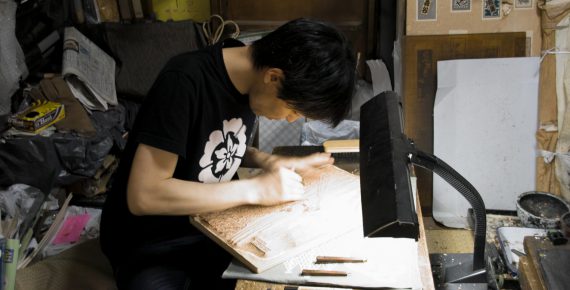Edo Moku-Hanga [ Woodblock Prints ]
Nagao Jirou

Edo woodblock printing is made through the hands of the three artisans, the "Eshi (painter)" who draws the sketch, "the “Horishi(carver)" who carves the picture on the woodblock, and the "Surishi” (printer) who uses woodblocks to print the picture on paper.
Jiro Nagao who is a Horishi third generation of the Nagao woodblock printmakers, works with his older brother, Yuji who is a Surishi. Nagao Woodblock Printmaker had previously engaged in woodblocks and specializing in printing, but since the carver that was being asked for carving works retired due to his age, Jiro learned the carving technique by himself and makes the business in current division of work.
For one woodblock print, several plates are carved and are used for printing in their respective colors. When carving, it seems that the touch of the painter’s brush (strength of the lines) is also aimed to fit the desired carving condition. Using his wood, his older brother, Yuji stretches the paint on the plate to Japanese paper such as Iyo paper, or Echizen paper etc., and prints them several times. When he demonstrated the creation of Edo woodblock printing abroad, it was said that his sophisticated technique made great excitement among the people.
There are only 20 to 30 Carver’s left now in Tokyo because the printing technique is being mechanized and Edo woodblock printmakers gradually dropped out of the business. But, Jiro said that even in these modern times, when machine printing has been developed, the Edo woodblock printing has better coloring than machine printing, and it’s distinctive and has a transparent feeling can not be created by machine printing.
The one that has a great impact from the observers is the Ukiyo-E printing which made by overlapping colors repeatedly. But most of the orders are actually the orders of Senjafuda (a votive card that worshipers hang at shrines or temples) and the Kokanfuda (exchange card). Recently, there are lots of people ordering not only for hanging it in shrines or temples but they are making and exchanging it as a hobby. In addition to this, there are also people making orders of postcards or stationeries such as petit envelopes, business cards, etc.
short version(1min30sec.)
long version
If you would like to know more about the craft history, manufacturing process, tools, etc., please check this movie.(6min54sec.)
Nagao Hangasho
1-1-1 Motoasakusa, Taitō-ku
TEL:03-3847-0772
※For inquiries Japanese only



